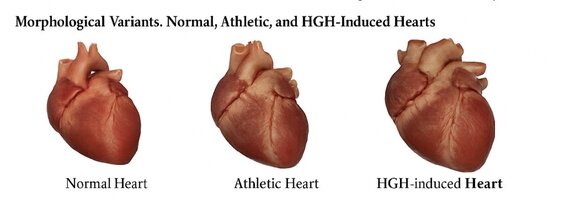Human Growth Hormone (HGH) is an anabolic peptide secreted by the anterior pituitary gland that stimulates tissue growth through the hepatic production of Insulin-like Growth Factor-1 (IGF-1).
In therapeutic or physiological doses, HGH promotes lean tissue accretion, bone density, and recovery. However, chronic supraphysiological administration commonly seen in bodybuilding protocols ranging from 2–6 International Units (IU) daily has systemic effects that extend to cardiac tissue.
Mechanism of Cardiac Remodeling
Growth hormone and IGF-1 act synergistically on cardiac myocytes, promoting protein synthesis and cellular hypertrophy. In short-term, low dose administration (e.g., 3 IU nightly for several months), this effect is typically mild and may improve stroke volume and cardiac output.
Over longer durations or in combination with anabolics or insulin, continuous stimulation of myocardial growth pathways can induce pathological remodeling characterized by thickened ventricular walls, reduced chamber compliance, and diastolic dysfunction.
Morphological Variants:
(Normal, Athletic, and HGH-Induced Hearts)

A normal heart exhibits balanced myocardial wall thickness (≈10 mm in the left ventricle) with optimal cavity volume and elasticity.
The athlete’s heart, a physiological adaptation to endurance or resistance training, shows symmetric hypertrophy enlarged chambers and proportional wall thickening that enhance cardiac efficiency. This form of remodeling is reversible with detraining.
The HGH induced heart often displays concentric hypertrophy:
Excessive myocardial wall thickness, diminished left ventricular cavity size, and increased myocardial stiffness. Unlike the athlete’s heart, this form of hypertrophy can become fibrotic and partly irreversible, predisposing to arrhythmias and heart failure if unmonitored.
Normal Heart weighs about:
Men: 280–340 grams (roughly 10–12 ounces)
Women: 230–280 grams (about 8–10 ounces)
That corresponds to about 0.45% of total body weight. A beautifully efficient muscle optimized for endurance, not mass.
Athlete’s Heart
In trained athletes, especially endurance or strength competitors the heart grows larger to meet higher circulatory demands.
Athletic heart: 350–500 grams
This growth is called physiological hypertrophy, chamber volume expands, walls thicken proportionally, and performance improves. This change is reversible; if training ceases, heart mass gradually returns toward baseline.
HGH-Induced or Pathological Hypertrophy
Now, in the case of long term HGH use, particularly at 3 IU or higher nightly for extended periods, studies and autopsy data mostly from acromegaly cases and some bodybuilder reports show:
HGH induced heart: 500–700 grams, sometimes exceeding 800 grams in severe cases.
This is pathological hypertrophy meaning the wall thickens disproportionately to the chamber size.
The myocardium becomes denser, stiffer, and heavier without proportional vascular support. It pumps harder but less efficiently, and that’s where the long term danger lies (arrhythmias, reduced diastolic filling, fibrosis).
Empirical and Clinical Evidence
Echocardiographic studies in long term acromegalic patients (naturally exposed to elevated GH) consistently demonstrate left ventricular hypertrophy and reduced diastolic compliance. Comparable findings have been observed in bodybuilders using exogenous HGH and anabolics concurrently. These data suggest that exogenous GH use, even at moderate nightly doses, can elicit measurable cardiac remodeling when sustained over years.
Monitoring and Risk Mitigation
To safeguard cardiovascular health, competitive athletes using HGH should employ routine echocardiography (every 6–12 months), resting blood pressure and heart-rate monitoring, and biochemical panels (lipid profile, glucose, hematocrit).
Cardiac adaptation can be favorably influenced by aerobic conditioning, dietary omega-3 fatty acids, and cycle modulation to allow normalization of endogenous GH and IGF-1 levels.
Ultimately,
A nightly dose of 3 IU of HGH does not acutely enlarge the heart, but chronic exposure particularly in multi-year regimens or combined anabolic protocols can transition from adaptive to maladaptive hypertrophy.
The distinction between an athlete’s heart and an HGH induced heart
lies not only in size but in structure, elasticity, and long-term function. Continuous monitoring is essential to preserve cardiovascular integrity while pursuing performance enhancement.
Isaac J. Hall II
IFBB Pro
In therapeutic or physiological doses, HGH promotes lean tissue accretion, bone density, and recovery. However, chronic supraphysiological administration commonly seen in bodybuilding protocols ranging from 2–6 International Units (IU) daily has systemic effects that extend to cardiac tissue.
Mechanism of Cardiac Remodeling
Growth hormone and IGF-1 act synergistically on cardiac myocytes, promoting protein synthesis and cellular hypertrophy. In short-term, low dose administration (e.g., 3 IU nightly for several months), this effect is typically mild and may improve stroke volume and cardiac output.
Over longer durations or in combination with anabolics or insulin, continuous stimulation of myocardial growth pathways can induce pathological remodeling characterized by thickened ventricular walls, reduced chamber compliance, and diastolic dysfunction.
Morphological Variants:
(Normal, Athletic, and HGH-Induced Hearts)

A normal heart exhibits balanced myocardial wall thickness (≈10 mm in the left ventricle) with optimal cavity volume and elasticity.
The athlete’s heart, a physiological adaptation to endurance or resistance training, shows symmetric hypertrophy enlarged chambers and proportional wall thickening that enhance cardiac efficiency. This form of remodeling is reversible with detraining.
The HGH induced heart often displays concentric hypertrophy:
Excessive myocardial wall thickness, diminished left ventricular cavity size, and increased myocardial stiffness. Unlike the athlete’s heart, this form of hypertrophy can become fibrotic and partly irreversible, predisposing to arrhythmias and heart failure if unmonitored.
Normal Heart weighs about:
Men: 280–340 grams (roughly 10–12 ounces)
Women: 230–280 grams (about 8–10 ounces)
That corresponds to about 0.45% of total body weight. A beautifully efficient muscle optimized for endurance, not mass.
Athlete’s Heart
In trained athletes, especially endurance or strength competitors the heart grows larger to meet higher circulatory demands.
Athletic heart: 350–500 grams
This growth is called physiological hypertrophy, chamber volume expands, walls thicken proportionally, and performance improves. This change is reversible; if training ceases, heart mass gradually returns toward baseline.
HGH-Induced or Pathological Hypertrophy
Now, in the case of long term HGH use, particularly at 3 IU or higher nightly for extended periods, studies and autopsy data mostly from acromegaly cases and some bodybuilder reports show:
HGH induced heart: 500–700 grams, sometimes exceeding 800 grams in severe cases.
This is pathological hypertrophy meaning the wall thickens disproportionately to the chamber size.
The myocardium becomes denser, stiffer, and heavier without proportional vascular support. It pumps harder but less efficiently, and that’s where the long term danger lies (arrhythmias, reduced diastolic filling, fibrosis).
Empirical and Clinical Evidence
Echocardiographic studies in long term acromegalic patients (naturally exposed to elevated GH) consistently demonstrate left ventricular hypertrophy and reduced diastolic compliance. Comparable findings have been observed in bodybuilders using exogenous HGH and anabolics concurrently. These data suggest that exogenous GH use, even at moderate nightly doses, can elicit measurable cardiac remodeling when sustained over years.
Monitoring and Risk Mitigation
To safeguard cardiovascular health, competitive athletes using HGH should employ routine echocardiography (every 6–12 months), resting blood pressure and heart-rate monitoring, and biochemical panels (lipid profile, glucose, hematocrit).
Cardiac adaptation can be favorably influenced by aerobic conditioning, dietary omega-3 fatty acids, and cycle modulation to allow normalization of endogenous GH and IGF-1 levels.
Ultimately,
A nightly dose of 3 IU of HGH does not acutely enlarge the heart, but chronic exposure particularly in multi-year regimens or combined anabolic protocols can transition from adaptive to maladaptive hypertrophy.
The distinction between an athlete’s heart and an HGH induced heart
lies not only in size but in structure, elasticity, and long-term function. Continuous monitoring is essential to preserve cardiovascular integrity while pursuing performance enhancement.
Isaac J. Hall II
IFBB Pro



